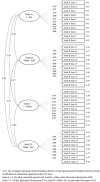Psychometric Properties of the Theory of Mind Assessment Scale in a Sample of Adolescents and Adults
- PMID: 27242563
- PMCID: PMC4860419
- DOI: 10.3389/fpsyg.2016.00566
Psychometric Properties of the Theory of Mind Assessment Scale in a Sample of Adolescents and Adults
Abstract
This research aimed at the evaluation of the psychometric properties of the Theory of Mind Assessment Scale (Th.o.m.a.s.). Th.o.m.a.s. is a semi-structured interview meant to evaluate a person's Theory of Mind (ToM). It is composed of several questions organized in four scales, each focusing on one of the areas of knowledge in which such faculty may manifest itself: Scale A (I-Me) investigates first-order first-person ToM; Scale B (Other-Self) investigates third-person ToM from an allocentric perspective; Scale C (I-Other) again investigates third-person ToM, but from an egocentric perspective; and Scale D (Other-Me) investigates second-order ToM. The psychometric proprieties of Th.o.m.a.s. were evaluated in a sample of 156 healthy persons: 80 preadolescent and adolescent (aged 11-17 years, 42 females) and 76 adults (aged from 20 to 67 years, 35 females). Th.o.m.a.s. scores show good inter-rater agreement and internal consistency; the scores increase with age. Evidence of criterion validity was found as Scale B scores were correlated with those of an independent instrument for the evaluation of ToM, the Strange Stories task. Confirmatory factor analysis (CFA) showed good fit of the four-factors theoretical model to the data, although the four factors were highly correlated. For each of the four scales, Rasch analyses showed that, with few exceptions, items fitted the Partial credit model and their functioning was invariant for gender and age. The results of this study, along with those of previous researches with clinical samples, show that Th.o.m.a.s. is a promising instrument to assess ToM in different populations.
Keywords: Th.o.m.a.s.; Theory of Mind; metacognition; social cognition; validation of ToM tests.
Figures
Similar articles
-
Mindreading abilities in sexual offenders: an analysis of theory of mind processes.Conscious Cogn. 2011 Dec;20(4):1612-24. doi: 10.1016/j.concog.2011.08.011. Epub 2011 Sep 15. Conscious Cogn. 2011. PMID: 21924641
-
Theory of mind deficit in subjects with alcohol use disorder: an analysis of mindreading processes.Alcohol Alcohol. 2014 May-Jun;49(3):299-307. doi: 10.1093/alcalc/agt148. Epub 2013 Sep 24. Alcohol Alcohol. 2014. PMID: 24064369
-
An exploratory assessment of theory of mind and psychological impairment in patients with bulimia nervosa.Br J Psychol. 2014 Nov;105(4):509-23. doi: 10.1111/bjop.12054. Epub 2013 Sep 30. Br J Psychol. 2014. PMID: 24117350
-
Theory of mind and paranoia in schizophrenia: a game theoretical investigation framework.Cogn Neuropsychiatry. 2011 Nov;16(6):505-29. doi: 10.1080/13546805.2011.561576. Epub 2011 May 23. Cogn Neuropsychiatry. 2011. PMID: 21563010 Review.
-
Meta-analysis of theory of mind in anorexia nervosa and bulimia nervosa: A specific İmpairment of cognitive perspective taking in anorexia nervosa?Int J Eat Disord. 2016 Aug;49(8):739-40. doi: 10.1002/eat.22572. Epub 2016 Jul 18. Int J Eat Disord. 2016. PMID: 27425037 Review.
Cited by
-
Executive Function and Theory of Mind in Children with ADHD: a Systematic Review.Neuropsychol Rev. 2018 Sep;28(3):341-358. doi: 10.1007/s11065-018-9381-9. Epub 2018 Aug 30. Neuropsychol Rev. 2018. PMID: 30168020
-
Theory of mind in adolescents with Attention-Deficit Hyperactivity Disorder: A cross-sectional study.Iran J Child Neurol. 2023 Winter;17(1):81-90. doi: 10.22037/ijcn.v17i1.39094. Epub 2023 Jan 1. Iran J Child Neurol. 2023. PMID: 36721828 Free PMC article.
-
What Do You Have in Mind? Measures to Assess Mental State Reasoning in Neuropsychiatric Populations.Front Psychiatry. 2019 Jul 4;10:425. doi: 10.3389/fpsyt.2019.00425. eCollection 2019. Front Psychiatry. 2019. PMID: 31354534 Free PMC article. Review.
-
Assessing the integrity of the cognitive processes involved in belief reasoning by means of two nonverbal tasks: Rationale, normative data collection and illustration with brain-damaged patients.PLoS One. 2018 Jan 30;13(1):e0190295. doi: 10.1371/journal.pone.0190295. eCollection 2018. PLoS One. 2018. PMID: 29381730 Free PMC article.
-
Sincere, Deceitful, and Ironic Communicative Acts and the Role of the Theory of Mind in Childhood.Front Psychol. 2017 Jan 30;8:21. doi: 10.3389/fpsyg.2017.00021. eCollection 2017. Front Psychol. 2017. PMID: 28194120 Free PMC article.
References
-
- Baron-Cohen S., O'Riordan M., Stone V., Jones R., Plaisted K. (1999). Recognition of faux pas by normally developing children and children with Asperger syndrome or high-functioning autism. J. Autism Dev. Disord. 29, 407–418. - PubMed
-
- Baron-Cohen S., Wheelwright S., Spong A., Scahill V., Lawson J. (2001). Are intuitive physics and intuitive psychology independent? A test with children with Asperger Syndrome. J. Dev. Learn. Disord. 5, 47–78.
LinkOut - more resources
Full Text Sources
Other Literature Sources


